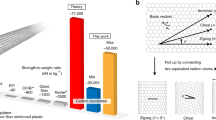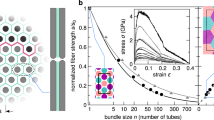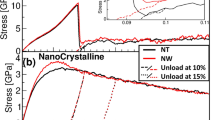Conditions have been discovered that allow extensive deformation of rigid single-walled nanotubes.
Abstract
The theoretical maximum tensile strain — that is, elongation — of a single-walled carbon nanotube is almost 20%1,2, but in practice only 6%3,4 is achieved. Here we show that, at high temperatures, individual single-walled carbon nanotubes can undergo superplastic deformation, becoming nearly 280% longer and 15 times narrower before breaking. This superplastic deformation is the result of the nucleation and motion of kinks in the structure, and could prove useful in helping to strengthen and toughen ceramics and other nanocomposites at high temperatures.
Similar content being viewed by others
Main
A single-walled carbon nanotube (SWCNT) with an initial length of 24 nm (Fig. 1a) was formed in situ by the electrical breakdown of a multiwalled carbon nanotube inside a high-resolution transmission electron microscope equipped with a piezo manipulator5. The piezo manipulator was used to pull the SWCNT to increase the strain (Fig. 1b–d), at a constant bias of 2.3 volts. At tensile failure, the SWCNT was 91 nm long, showing a tensile elongation of 280%; its diameter was reduced 15-fold, from 12 to 0.8 nm. As the SWCNT segment was clamped between the layers of the multiwalled carbon nanotube, the possibility of wall-sliding during elongation is ruled out. The diameter of the elongated nanotubes did not change significantly when wall-sliding occurred.
a–d, Tensile elongation of a single-walled carbon nanotube (SWCNT) under a constant bias of 2.3 V (images are all scaled to the same magnification). Arrowheads mark kinks; arrows indicate features at the ends of the nanotube that are almost unchanged during elongation. e–g, Tensile elongation of a SWCNT at room temperature without bias (images e and f are scaled to the same magnification). Initial length is 75 nm (e); length after elongation (f) and at the breaking point (g) is 84 nm; g, low-magnification image of the SWCNT breaking in the middle.
A 280% tensile strain and 15-fold reduction in diameter are unprecedented in a SWCNT. Ropes of single-walled3,4 and multiwalled6 carbon nanotubes break at strains of less than about 6% and 12%, respectively, which is significantly less than that seen here. We propose that the super-elongation we observe is due to a fully plastic deformation mechanism that occurs at high temperatures.
During deformation at a bias of 2.3 V, the temperature in the middle of the SWCNT is estimated to be more than 2,000 °C (see supplementary information). At such high temperatures, the nanotube seems to be completely ductile. Kinks and point defects are fully activated, resulting in superplastic deformation impossible at low temperatures. Kinks form frequently during tensile straining (Fig. 1b–d), propagate along the tube and then pile up (Fig. 1d) or disappear at the ends (for movie, see supplementary information).
The kink motion is evidence of kink-mediated plasticity at high temperatures. The nanotube narrows immediately after the kink passes. We suggest that these kinks are associated with one or several unit dislocations that have a Burgers vector of 1/3 <1120> type.
Such large plastic strains in nanotubes demonstrate their ductile nature at high temperatures7,8,9. In contrast, tensile-pulling experiments at room temperature without any bias showed that almost all nanotubes failed at a tensile strain of less than 15% (Fig. 1e–g). Our experimental evidence (not shown) shows that, as well as kink nucleation and motion, atom diffusion is important during superplastic deformation, helping to heal defects such as vacancies and to prevent the formation of large rings that might initiate cracks and lead to failure of the strained nanotube.
When the diameter and length of a SWCNT change in this dramatic way, the current flowing in the nanotube drops sharply from 80 μA to almost zero, causing the current density to drop from 109 to 108 A cm−2 and then to almost zero (for details, see supplementary information). An increase in defect density causes this rapid fall in current density as the nanotube diameter decreases.
Our surprising discovery of superplasticity in nanotubes should encourage the investigation of their mechanical and electronic behaviour at high temperatures. They may be useful as reinforcement agents in ceramics and other nanocomposites for high-temperature applications9,10,11.
References
Zhao, Q. Z., Nardelli, M. B. & Bernholc, J. Phys. Rev. B 65, 144105 (2002).
Nardelli, M. B., Yakobson, B. I. & Bernholc, J. Phys. Rev. B 57, R4277–R4280 (1998).
Walters, D. A. et al. Appl. Phys. Lett. 74, 3803–3805 (1999).
Yu, M. F., Files, B. S., Arepalli, S. & Ruoff, R. S. Phys. Rev. Lett. 84, 5552–5555 (2000).
Huang, J. Y. et al. Phys. Rev. Lett. 94, 236802 (2005).
Yu, M. F. et al. Science 287, 637–640 (2000).
Nardelli, M. B., Yakobson, B. I. & Bernholc, J. Phys. Rev. Lett. 81, 4656–4659 (1998).
Orlikowski, D., Nardelli, M. B., Bernholc, J. & Roland, C. Phys. Rev. Lett. 83, 4132–4135 (1999).
Calvert, P. Nature 399, 210–211 (1999).
Zhan, G. D., Kuntz, J. D., Wan, J. L. & Mukherjee, A. K. Nature Mater. 2, 38–42 (2003).
Baughman, R. H., Zakhidov, A. A. & de Heer, W. A. Science 297, 787–792 (2002).
Author information
Authors and Affiliations
Corresponding author
Ethics declarations
Competing interests
The authors declare no competing financial interests.
Supplementary information
Supplementary movie
An in situ HRTEM movie shows a kink that is emitted from the upper junction between the double-walled carbon nanotube segment and the multiwalled carbon nanotube, propagates along the nanotube, and finally disappears at the lower junction. The bias is 2.4 V and the current is 155 µA during the kink motion. The images are acquired with a rate of 3 frames/s and are displayed with 2x2 speed. The image size is 86x86 nm2. (MOV 4115 kb)
Supplementary Figure
(DOC 79 kb)
Rights and permissions
About this article
Cite this article
Huang, J., Chen, S., Wang, Z. et al. Superplastic carbon nanotubes. Nature 439, 281 (2006). https://doi.org/10.1038/439281a
Issue Date:
DOI: https://doi.org/10.1038/439281a
This article is cited by
-
Failure-analysis of carbon nanotubes and their extreme applications
Nano Research (2023)
-
Direct observation of the formation and stabilization of metallic nanoparticles on carbon supports
Nature Communications (2020)
-
Buckling Failure Analysis of Defective Carbon Nanotubes Using Molecular Dynamics Simulation
Journal of Failure Analysis and Prevention (2020)
-
Removal of heavy metals and radionuclides from water using nanomaterials: current scenario and future prospects
Environmental Science and Pollution Research (2020)
-
Electron-beam-induced uniform elongation of multi-walled carbon nanotube
SN Applied Sciences (2019)
Comments
By submitting a comment you agree to abide by our Terms and Community Guidelines. If you find something abusive or that does not comply with our terms or guidelines please flag it as inappropriate.




